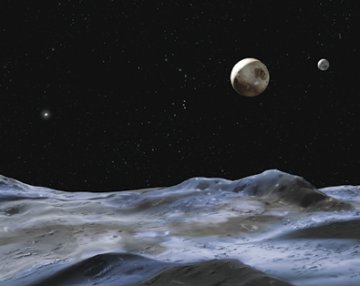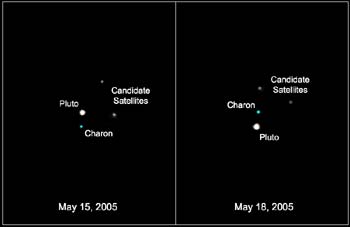Pluto’s New Moons
Astronomers have spotted two objects that may be previously unknown moons of Pluto.
By Emily Sohn
The first time that you learn about the planets, it all seems so simple. There are nine of them, including Earth. All orbit the sun. Then, you learn about moons, and things get a little more complicated. Moons orbit planets. We have one. Saturn has more than 45.
As soon as you’ve memorized the planet lessons in your textbook, however, you’ve got more work to do. The Hubble Space Telescope has just spotted two more moons around Pluto, adding to the one we already knew about. If the finding is true, astronomers will have to rethink what they know about the planet and about the Kuiper belt—a collection of small, icy objects that lingers way out on the edge of our solar system.
 |
|
The imagined surface of one of the two newfound moons of Pluto shows the planet above the horizon. The previously known moon, Charon, lies to the right of the planet, and the other new moon is at the far left.
|
| NASA, ESA, and G. Bacon (STScI) |
Until now, scientists had supposed that Pluto had just one moon, called Charon. This object follows an orbit 19,600 kilometers (12,200 miles) from the planet and measures 1,270 kilometers (790 miles) across. Charon is about half as wide as Pluto.
The new moons have been named S/2005 P1 and S/2005 P2. The first one lies about 48,000 kilometers (30,000 miles) from Pluto and has an estimated diameter of 56 kilometers (35 miles). The second lies about 64,000 kilometers (39,800 miles) from Pluto and has a diameter of about 48 kilometers (30 miles).
For every 12 times that Charon goes around Pluto, it looks like S/2005 P1 goes around 3 times, while S/2005 P2 goes around twice. Based on this information, scientists suspect that the moons formed at the same time that Charon formed, when some massive object smashed into Pluto soon after the planet’s birth 4.5 billion years ago. Chunks that flew off in the collision then became moons when they were trapped by the planet’s gravity.
 |
|
These two images from the Hubble Space Telescope show the positions of Pluto, Charon, and the two objects that may be additional moons of Pluto. The movements of these objects, shown three days apart, suggest that they orbit Pluto.
|
| NASA, ESA, H. Weaver (JHU/APL), A. Stern (SwRI), and the Hubble Space Telescope Pluto Companion Search Team |
More observations are needed to confirm that the two objects actually orbit Pluto, but astronomers have reason to believe that they do. The same two objects also appear in pictures taken by Hubble 3 years ago.
After finishing with your textbook, keep watching the news. It’s the only way to keep up with our constantly changing map of outer space.—E. Sohn
Going Deeper:
Cowen, Ron. 2005. New partners: Hubble finds more moons around Pluto. Science News 168(Nov. 5):291. Available at http://www.sciencenews.org/articles/20051105/fob1.asp .
You can learn more about the discovery of Pluto’s new moons at hubblesite.org/newscenter/newsdesk/archive/releases/2005/19/ (Space Telescope Science Institute).
Sohn, Emily. 2005. Solving a Sedna mystery. Science News for Kids (May 4). Available at http://www.sciencenewsforkids.org/articles/20050504/Note3.asp .
______. 2004. Icy orbs at the solar system’s edge. Science News for Kids (Dec. 1). Available at http://www.sciencenewsforkids.org/articles/20041201/Note2.asp .
______. 2004. Planets on the edge. Science News for Kids (April 7). Available at http://www.sciencenewsforkids.org/articles/20040407/Feature1.asp .







